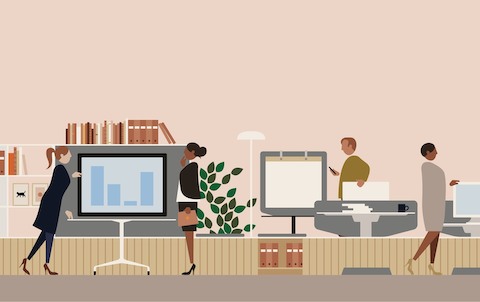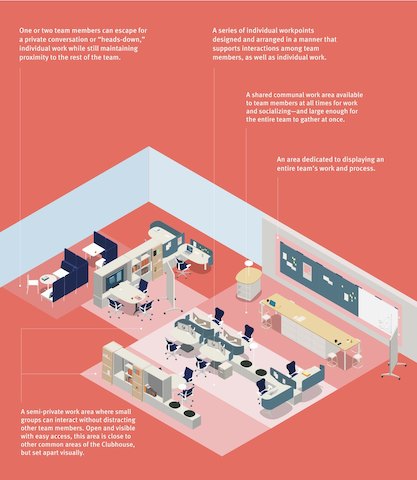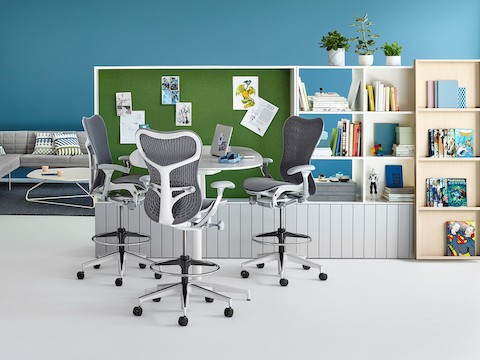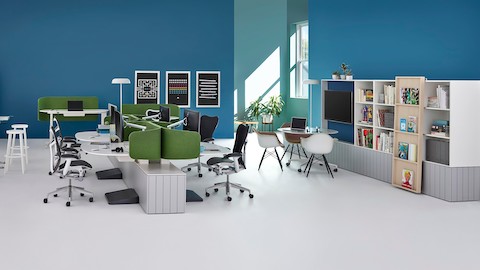The Vital Link Between Improvisation and Innovation
Innovation Requires New Ways of Thinking and Working
Download PDF (1.4 MB)
Key Points
- Companies that innovate most quickly are often the most successful, and innovation requires new ways of thinking and working.
- The distinguishing characteristic of innovative teams is the fluid, improvisational way they move between activities.
- An example of how the workplace can be used strategically to advance business goals, the Clubhouse Setting was designed to support the way innovative teams work.
- Locale was designed to be a purposeful fit for highly collaborative neighborhoods such as Clubhouses.
In a recent survey by PwC, 78 percent of CEOs from around the world said they expect their efforts at innovation to generate “significant” new ways of making money in the next three years.1 There’s little argument among business leaders about the importance of innovation. There’s also surprising agreement on how best to foster this seemingly elusive business outcome: bring people together and provide room for them to build upon one another’s ideas.
An international study commissioned by Google found an 81 percent correlation between collaboration and innovation. One example of that correlation from the report: “UK employees who are given the opportunity to collaborate at work are almost twice as likely to have contributed new ideas to their company.”2

The kinds of freeform thinking, synthesis, and social engagement required for successfully inventing and reinventing new solutions to problems are very different from that of procedural, linear, and algorithmic work that successfully lets us scale, repeat, and maximize the solutions we already know.
While the work has changed, becoming more fluid, creative, and collaborative, many offices have not. Most offices are still geared toward linear work, providing just two primary kinds of spaces, i.e., workstations and conference rooms. To help solve this problem, Herman Miller is constantly doing research to garner a greater understanding of people, work, and place. Some of that research led us to develop our Living Office framework, which helps organizations and their design partners create office landscapes made up of settings optimized to support particular activities.
As we studied the ways companies foster the conditions in which innovative and creative teams can flourish, our research showed that the nature of these teams and their work is often improvisational.3 Their approach to work activities was similar to a jazz ensemble’s approach to playing music, with each member riffing and playing off the others. Members transitioned often and fluidly from working alone to working together. They moved from generating new ideas as a large group to working in parallel in small groups to get the job done. Team members made these transitions as needed, not according to a process or a plan.
Innovation Incubator: The Clubhouse
Each organization is unique, so their workplace should be too. Even when two companies share the same business goal, their spatial recipe of settings will likely vary based on other factors, including the company’s purpose and character.
While there isn't only one way to achieve innovation, there is one setting, the Clubhouse, that was created specifically to support the fluid, improvisational work activities of highly collaborative teams. In a Clubhouse, team members never have to sacrifice connection to one another in order to work in a setting that's optimized for the activity at hand. They can remain immersed in their work, achieving a state of flow.
Anatomy of a Clubhouse
The Clubhouse is uniquely suited to highly collaborative teams because it contains five kinds of work areas arranged in proximity to each other to support the activities of the team. While the actual arrangement of the areas will vary based on the nature of the work and the team interactions, the proximity of those work areas is what’s critical. Our research showed that these teams felt that physical presence was essential to the team and their work. When team members are able to work side by side, its easier for them to connect, ask questions, solve problems together, and draw energy from one another.
The first kind of work area within a Clubhouse is comprised of a series of individual workpoints designed and arranged in a manner that supports interactions among team members, as well as individual work. This area serves as a home base, where team members may spend the majority of their time and where many of the fluid transitions take place. Equipped with tools, ergonomic support, and personal space appropriate to the work, it’s the best place to do individual work while being present for the team. Its openness aids the team in many ways. Because team members can see and hear the way their colleagues work, it helps quickly establish and reinforce team norms. Clear sight lines also make it easier for team members to collaborate and give feedback on the fly.
Clubhouses also contain a semi-private space where small groups can work together without distracting other team members. This work area is team-owned, tailored to suit the team’s needs, and generally provides a way to “change things up” in perspective or posture. Open and visible with easy access, this space is close to individual workpoints of the Clubhouse, but set apart visually.
The “epicenter,” another of the work areas, is the heart and lifeblood of the Clubhouse. This team-owned, communal space is available to team members at all times for work and socializing, and it's large enough for the entire team to gather at once. It connects people, conveys identity often through artifacts displayed on a surface, and contributes to a sense of belonging. An epicenter works best when it’s highly visible and close to individual workpoints.
The fourth kind of work area within a Clubhouse is the “wall of awareness”—an area dedicated to displaying an entire team’s work and process. Making work and process visible increases accountability, invites contribution, and helps the team make connections to other work while identifying missing pieces. All of these increase team effectiveness and efficiency. When team members can see and react to flow charts, drafts, and timelines, for example, work speeds up.
Finally, a Clubhouse has a do-not-disturb zone to which one or two team members can escape for a private conversation or “heads-down,” individual work while still maintaining proximity to the rest of the team. Ideally, this work area is easy to access, since the need for private conversations often comes up quickly.
Because it contains this particular blend of work areas in close proximity to each other, the Clubhouse supports the improvisational style of collaborative teams, reducing time lost during transition between activities, and fostering connection and belonging among team members.

A Clubhouse is comprised of five kinds of spaces, the arrangement of which will vary based on the nature of the resident team's work and interaction among team members. The close proximity of these spaces within the setting is essential.
The Logic of Locale
While Clubhouses can be created with a variety of products, Herman Miller’s Locale was designed to be a purposeful fit for high-performing neighborhoods, aka Clubhouses. “Collaborating is not linear, where one idea leads directly to another, improving as it goes along and gaining consensus,” says Kim Colin, Locale’s co-designer, along with Sam Hecht. “Instead, the process is unpredictable and spontaneous, random, and a little chaotic.”4
Colin and Hecht created Locale with the intention of allowing team members to seamlessly transition between working together and alone, and between seated and standing postures, all within open plan office environments.
“Locale brings different parts of the office in proximity,” says Hecht. “You shouldn’t have to move to completely separate spaces to accommodate varied work styles.”5
Locale’s elements—a variety of height-adjustable work surfaces; mobile tables, screens, and easels; and cabinets for storage and display—give people the flexibility to create custom settings for individual work and informal meetings. And its curved “gather round” surfaces signal openness, invite interaction, and generously accommodate multiple collaborators, work styles, postures, and tools.

John Deere’s Test Run
A small team of Intelligent Solutions Group (ISG) managers at John Deere experienced for themselves the benefits of using Locale to create a Clubhouse Setting. The team is particularly pleased with the way their Clubhouse provides multiple points for individual and group tasks and the freedom to shift instantly and intuitively among them.
“If you have to think about collaborating, you’re losing time,” says Casey Schrock, Director of Facilities for John Deere. “The way our ISG teams work, there always seems to be this interplay between individual and group work. The faster we can transition between the two, the more efficient we can be.”6
The combination of a Clubhouse Setting and Locale is a powerful one. A thoughtful composition of Locale’s various elements supports the highest-level goals of the Clubhouse, creating a highly adjustable environment where team members can move fluidly between individual tasks and work together over the course of the day. And improvisation—that hallmark of innovative teams—becomes not just possible, but completely natural.
1. PwC, “Growth Reimagined: Prospects in Emerging Markets Drive CEO Confidence,” 14th Annual Global CEO Survey Main Report, 2011, p. 9.
2. BBC News, "Google: Mobile, Social, Cloud Changing the Way We Work," originally published Feb. 3, 2012, http://www.bbc.co.uk/news/mobile/business-16858085.
3. Herman Miller, “Team Landscapes: Total User Experience II,” confidential research, 2015
4. Sam Hecht & Kim Colin, "How Can We Work Better?," Locale, (Industrial Facility, 2014), p. 29.
5. Herman Miller, "Case Studies: John Deere," originally published in 2014, http://www.hermanmiller.com/research/case-studies/john-deere.html.
